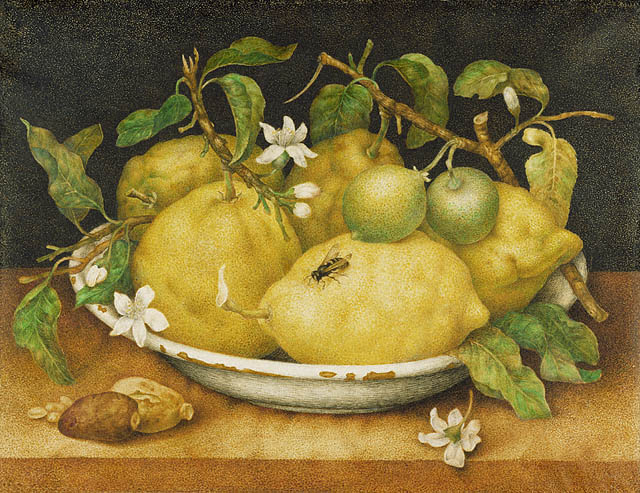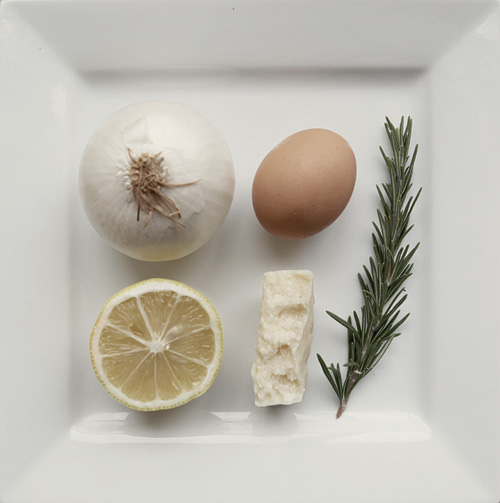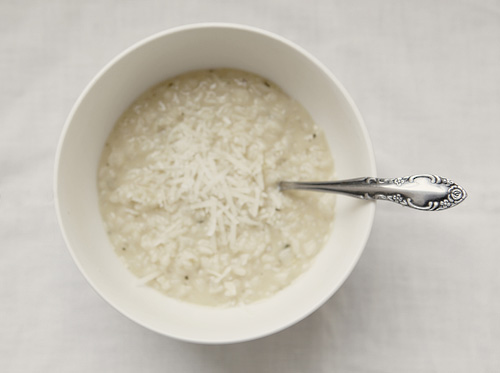If you are familiar with still life paintings then you will know that the majority of them will feature a lemon somewhere on the canvas. Traditionally citrus fruits represented the wealth of the patron commissioning the painting because they were exotic commodities that required a substantial sum of money to acquire. In an era where artists were treated as craftsmen, the lemon became a test for the artist to demonstrate skill in illustrating the different manipulations of light. The paint was carefully applied to depict the lustrous light glowing from within the semi-translucent flesh of the lemon with the delicately cut peel curled in a long tendril showing a complex perspective (example here).

Tempera on vellum, 27.6 x 35.2 cm, J Paul Getty Museum
Giovanna Garzoni was one of the very first female still life painters at at time when it was unusual for there to be female artists in Italy. Common themes in her work were fruits, vegetables, and flowers all painted in a decorative style (1). She enjoyed great success during her lifetime with patronage by the Medici court and according to one writer she could sell her work “for whatever price she wished” (2). Her meticulous attention to detail is evident in the still life above and it is a prime example of natura sospensa (“nature suspended”) paintings that were popular in the court in the 1600s (3). Still Life with Bowl of Citrons (1640s) shows the way Garzoni would manipulate shapes and textures within the composition. The sharp and rough branches contrast with the smooth leaves and delicate flowers and the shape and texture of the citrons is replicated in the two nuts.

Risotto originated from the north of Italy where there are a multitude of rice paddies and it is one of the pillars of Milanese cuisine. In order to qualify as risotto the rice must be a high-starch, low-arnylose round medium rice grain and cooked in a very specific established process (otherwise the Italians call it a rice dish, not risotto). The best and most expensive varieties of risotto rice are considered to be Carnaroli and Vialone Nano grains and they make the creamiest risottos (4). Italy is Europe’s largest producer of rice and there is documentation detailing the cultivation of rice as far back as 1475. Risotto is a very versatile dish and unsurprisingly each region has its own variation (5). Whether it be with truffles in Piedmonte or seafood in Venice or even the traditional risotto with sauteed eels at Christmas there is sure to be a flavor combination for everyone.

Lemon Risotto
adapted from Nigella Bites
serves 4-6
1 white onion
1/2 cup unsalted butter
1 TB olive oil
1 1/2 cups risotto rice
1 litre vegetable stock (recipe below)
zest and juice of 1/2 of a lemon
needles from one sprig of rosemary, finely chopped
1 egg yolk
4 TB grated Parmesan
4 TB heavy cream
salt and pepper to taste
Chop the onion into a very very fine texture. Heat half of the butter and the oil in a large saucepan and cook the onion for about 5 minutes until it becomes translucent but before it starts to colour. Add the rice and mix to coat in the oil/butter mixture. Meanwhile, heat the stock in another saucepan to the point where it is simmering.
Pour a ladelful of the stock into the rice and keep stirring until it is absorbed. Then add another ladelful and stir again. Continue until all of the stock is absorbed or until the rice is al dente.
Mix the lemon zest and the finely chopped rosemary into the risotto. In a small bowl beat the egg yolk, lemon juice, Parmesan, cream and pepper.
Take off heat when the risotto is ready and mix in the eggy mixture and the remaining butter. Salt and pepper to taste and serve with more grated cheese if you wish.

Homemade Vegetable Stock
makes 1 litre
1 TB vegetable oil
2 large brown onions, halved
2 large carrots, quartered
2 parsnips, quartered
2 potatoes, quartered
2 stalks celery, quartered
12 cups cold water
small handful of parsley (left on stems)
10 dried peppercorns
3 dried bay leaves
Heat the oil in a stockpot over medium high heat. Add the vegetables and cook until brown, about 5 minutes.
Add the water, parsley, peppercorns, and bay leaves. Bring to a boil. Use a slotted spoon to remove any scum that rises to the surface. Reduce the heat to medium-low and simmer, uncovered. for 2 hours. Remove from heat and set aside for 30 minutes to cool slightly.
Strain through a fine sieve over a heatproof bowl. Discard contents of sieve and cool the stock to room temperature.
Cover the stock with plastic wrap or place in an airtight container to store in fridge. Alternatively freeze in ice cube trays to easily add flavor to soups and stews.

8 comments
Julie says:
Apr 27, 2009
What is the significance of the fly on the citron?
dessert girl says:
Apr 29, 2009
I love risotto. So comfy! AND you make your own stock?? Fancy! I’m also from Southeast Michigan! I grew up in W. Bloomfield. Yes, I can admit it. :-)
kellypea says:
May 3, 2009
Love, love, love apple crisp but have never made it to enjoy with caramel sauce. What a perfect idea.
Lorraine @NotQuiteNigella says:
May 4, 2009
Now I didn’t know that about citrus fruit being a fruit of the wealthy. Fascinating! And having had lemon risotto, I can definitely imagine how delicious this would be :)
Berndt’s Pear, Goat Cheese & Prosciutto Pizza »Feasting on Art says:
Jan 22, 2010
[…] of this period was an aesthetic climax – the scientific and artistic enthusiasm evident in natura sospensa paintings from the Renaissance manifested in the botanical books of the 19th […]
Coorte’s Pickled Asparagus »Feasting on Art says:
Apr 26, 2010
[…] Year Ago: Garzoni’s Lemon Risotto with Homemade Stock Tags: Asparagus, chili, Coorte, dill, garlic, Italian, mustard, pickled, preserve, vinegar […]
Lisa says:
Nov 12, 2012
I just found you through Saveur Magazine – I love your blog! I am an artist, recently turned food blogger. I used to paint food and think of food all the time while I was painting other things and finally and happily I gave myself over to making food my full time job. I’m having so much fun exploring your site! So creative!
Megan Fizell says:
Nov 12, 2012
Thanks Lisa, good luck with your new blog!